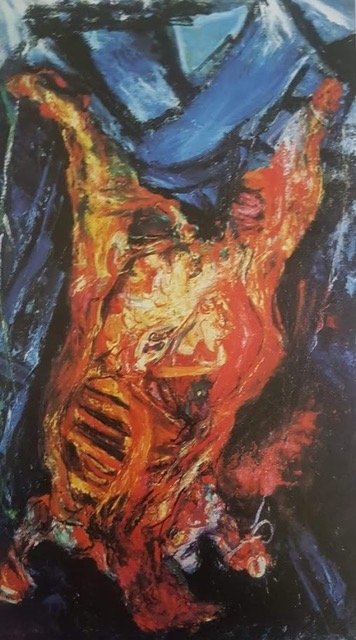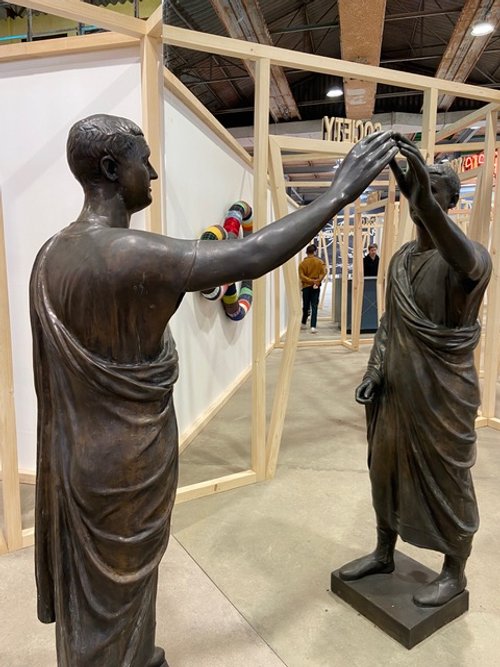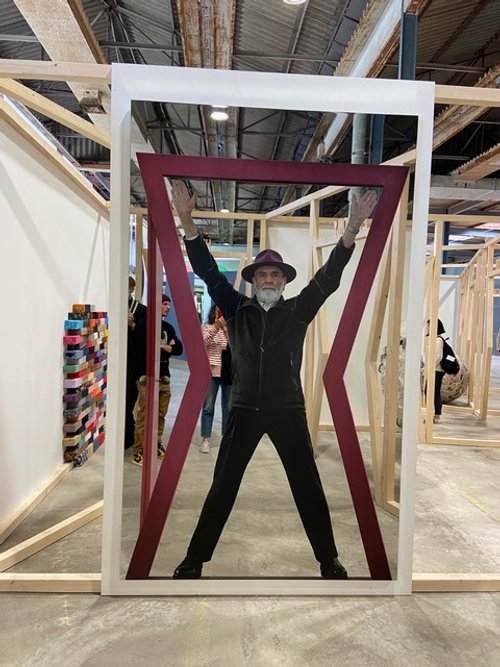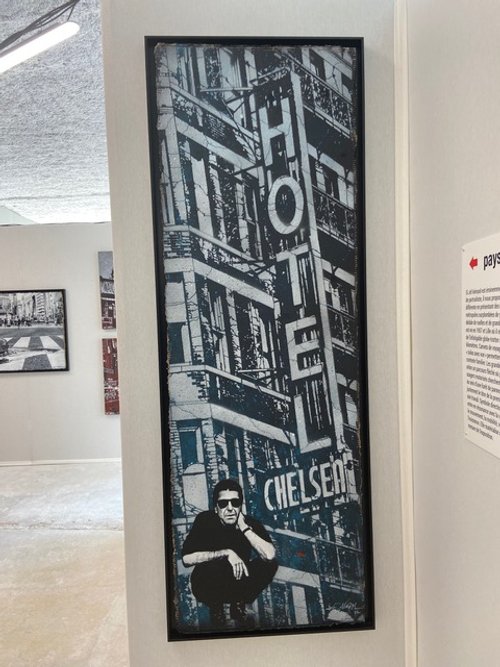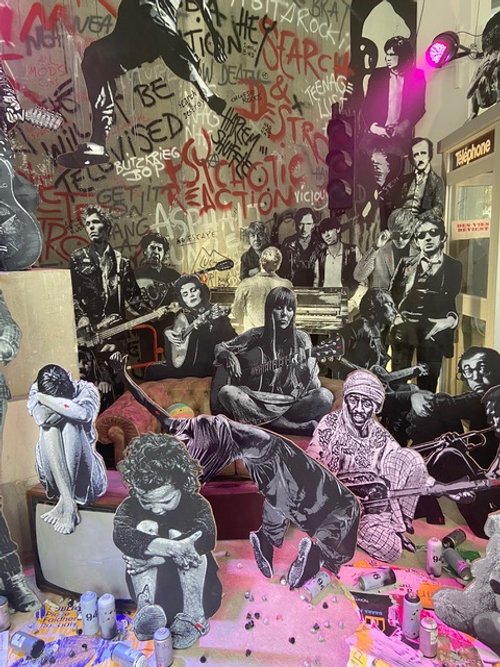Busy Bees
Newsletter September 25, 2022
Bienvenue and welcome back to Musée Musings, your idiosyncratic guide to Paris and art. As I mentioned last week, I had been going pretty easy on Nicolas, culture wise for a week or so because I had a pretty full calendar lined up for us this past weekend. It was the Journées de Patrimoine. Last year, since I had no one to please but myself and since I am a glutton, I visited three places each day. This year, I was more circumspect.
The Journées du Patrimoine, the annual ‘Open Door Days’ in France is always held the 3rd weekend in September. By ‘always’ I mean since 1984, when François Mitterand was President and Jack Lang was the Minister of Culture. That year, Lang got the idea of opening the doors to places normally closed to normal French citizens. He called it ‘La Journée portes ouvertes dans les monuments historiques’. This is how he explained it: “these monuments are yours, they were built by your predecessors, they were bequeathed by your elders. Today, it is thanks to your taxes that we maintain and restore them so that they can be passed on to new generations tomorrow.” Eight years later, France’s annual Journée portes ouvertes had become so popular that a second day was added and the name was changed to Journées du Patrimoine.
If you are in France, you are welcome to visit places that are either normally closed to the public and places for which there is a normally an entry fee. These places include museums, monuments, churches, theaters, chateaux, villas, private residences, banks, government buildings.
Last year was the first year I took advantage of the Journées du Patrimoine. I’m not a fan of free first Sundays at museums, either. The idea of standing in line for hours to be herded through the Élysée Palace has never appealed. But a newsletter popped into my email box, last year, Secrets of Paris (https://secretsofparis.com/), with a list of cultural institutions for which reservations were required. No standing in line to get into an overcrowded venue. This would be reserving a spot for a place I could not visit otherwise. And for free. What’s not to like?
Last year, I wanted to visit La Ruche but I was too late. So this year, I reserved our tickets as soon as I could. La Ruche is where the artists who had their studios at Le Bateau Lavoir went, when they abandoned Montmartre and headed to Montparnasse. La Ruche, in the 15th arrondissement, on Passage Danzig, is a three-story circular structure that looks like a large beehive, a ruche. (Figure 1) Hence the name. Gustave Eiffel designed it to display the wines of Bordeaux for the 1900 Exposition Universelle. Like the structure he built for the 1889 exposition, the Eiffel Tower, La Ruche was meant to be temporary. But the sculptor and philanthropist, Alfred Boucher had it dismantled and re-erected as artists’ studios. On land that was the outskirts of town, on land that was very inexpensive to buy.
Figure 1. Model of La Ruche
At La Ruche, the rent was cheap and no one was evicted for non-payment. There’s a story about a Russian painter who got off the train in Paris with 3 rubles in his pocket and 2 French words in his head, "Passage Danzig”. That was all he needed to get to La Ruche. Oh, I forgot to mention, maybe it was also cheap because it was just down the road from an abattoir (slaughterhouse). The sounds of animals being slaughtered must have been awful, the smell, horrific.
More than a few artists whose names we now know, called La Ruche home, at least for a while. Among them, Marc Chagall, Amadeo Modigliani and Chaim Soutine. The abattoir provided Soutine with inexpensive, I mean, free subjects - animal carcasses. (Figure 2) One time, the stench from a decaying carcass that Soutine was painting was so bad that another artist at La Ruche called the police. Another time, Chagall saw blood leaking out of Soutine’s room and rushed out of La Ruche screaming,"Someone has killed Soutine.” His carcass paintings are now amongst his most well-known.
Figure 2. Boeuf écorché, Chaim Soutine
La Ruche went into a period of decline mid century but recently has been revitalized with artists once again filling the wedge shaped studios. The studios have been enlarged so there are less artists here than at the turn of the 20th century. Our guide, an artist who has a studio at La Ruche, and who is not an art historian specializing in early 20th century art in Paris, said it was because artists work on a much grander scale now. We had a nice walk around the inside of the beehive but I wish that some studios had been open for this visit. As it was, we could only glance into a few of the studios whose doors had been left slightly ajar. (Figure 3) The guide didn’t know which studio had been Chagall’s, which Soutine’s, which Modigliani’s, etc. which was a disappointment, maybe nobody knows. But it was nice to wander around the interior and also to see the exterior garden. (Figure 4) I can imagine that it was a very congenial spot for artists to work and to relax. There was also an exhibition at the on-site gallery and that’s where the tour ended (Figure 5). The tour was in French so Nicolas zoned out and the 15th is Nicolas’ least favorite (after the 16th) so the visit was not a complete success.
Figure 3. La Ruche atelier
Figure 4. La Ruche, garden
Figure 5. Gallery exhibition at La Ruche, ceramic cabbages
My choice for Sunday’s excursion was a little different. An invitation from a commercial gallery had popped into my email mailbox a few weeks earlier. It was from the GalleriaContinua, whose outpost in the Marais I visit often and about which I have written. The gallery also has two other galleries, a kilometer apart, in the outskirts of Paris. The invitation offered free transportation to and from Paris to those galleries and guided tours and live entertainment once there. The only hitch was that we would leave at 11 a.m and not be back until 5 p.m. It was a commitment, so I invited one of Nic’s friends to join us. We boarded the bus at Jardin des Plantes (10 minute metro ride from my apartment) at 11:00 a.m. and we were in the French countryside an hour later.
The GalleriaContinua is part of a ‘chain’ of galleries founded 30 years ago by three Italian friends. Their first gallery was in Italy, which is not a surprise. But where they opened their first gallery, is. San Gimignano, that charming medieval Tuscan village, renown for its torri (towers) of which 14 of the original 72 survive. Opening a gallery of contemporary art in a small medieval village, even one as cute as San Gimignano, even one which is a UNESCO World Heritage Site, seems completely insane. San Gimignano is the opposite of urban and cool. But it worked 30 years ago and it is still working. These three guys have since built upon their success in San Gimignano by opening other galleries in Italy and around the world - from China and Cuba to Brazil and France.
Their goal has been, since the beginning, ‘to engage with the widest possible audience,’ to find ‘new forms of dialogue and symbiosis between unexpected geographies: rural and industrial, local and global, the art of the past and the art of today, famous and emerging artists’
They founded Le Moulin de Boissy, an hour outside of Paris, in 2007 and the Moulin de Sainte Marie three years later. Like their gallery in the Marais, these are raw, unfinished and a little edgy. But unlike their Paris gallery, they are huge, each consisting of several industrial spaces and the terrain around them, at one an outdoor sculpture garden, (Figure 6) at the other, an outdoor performance space.
Figure 6. GalleriaContinua, Le Moulin de Boissy, exterior sculpture garden
At Sainte-Marie the huge central space has been taken over by an installation by the Indian artist Subodh Gupta. Called ’My Village’ it is both sculptural and architectural. Made of many small tin and stainless steel objects, useful objects, functional objects, all related in some way to food. Some of which are familiar to everybody - like colanders and pots and tea kettles. Some of which speak to Gupta’s native country - specifically tiffins, those multi-layered containers in which travelers in India pack and eat their food. So, these are tools for cooking and preserving food, containers for offering and eating food. All of which, according to the gallery sheet, “constitute a central and recurrent motif in Indian life, both religious and cultural, from its earliest times up until today.” (Figures 7, 8, 9)
Figure 7. My Village overview, Gubodh Gupta, GalleriaContinua
Figure 8. My Village, teapot detail, Subodh Gupta
Figure 9. My Village, detail, Subodh Gupta, GalleriaContinua
The installation includes both small groupings of these tools/containers and large ones. Like stalactites and stalagmites, some grow from the floor, some fall from the ceiling. Of course nothing is falling and nothing is growing but there is a certain destabilization as you make your way through the exhibition. It is like a maze and in that way it is architectural since the placement of the groupings of objects defines your progression through space. It is beautiful in its simplicity and dynamic in its intricacy.
At the Moulin de Boissy, I was transfixed by an enormous exhibition space filled with works from different periods in the career of the artist, Michelangelo Pistoletto, a fixture at GalleriaContinua’s Marais gallery. But here the works are multiples and on a grand scale. The use of mirrors in so many of the pieces has the viewer constantly questioning reality. And some mirrors, rather than seeing what you think you are looking at, like your face for example, you see what is behind you - very useful for seeing if you still look good in those jeans! There are some images which remind you of something else, like a pointing finger that when seen in a mirror becomes two pointing fingers (Figure 10) and the reference to Michelangelo’s Creation of Adam seems obvious to me (Figure 11). But here, who needs Adam, or God, or whomever ….
Figure 10.Channeling Michelangelo, Michelangelo Pistoletto
Figure 11. Creation of Adam, Michelangelo
And then there is the standing Greek Orator (Figure 12) who really is talking to himself. And then I obviously had to take a Selfie (Figure 13). And then there was the artist himself in the labyrinth of X shaped wooden 2 x 4s (Figure 14) Eventually it was time to board the bus back to Paris. Rather than taking the metro home, we strolled along the Seine instead. A very agreeable ending to our day.
Figure 12. Greek Orator gesturing to himself, Michelangelo Pistoletto
Figure 13. Taking a Selfie, of course
Figure 14. The Artist, echoing the shape that defines this labyrinth space, Michelangelo Pistoletto
And finally, Nicolas joined me for a press preview at the Galerie Mathgoth) at 147 Avenue de France in the 13th (https://www.mathgoth.com/. It’s a gallery with the same raw and unfinished sensibility as the GalleriaContinua, which as you can probably tell by now, I find very appealing for exhibitions of contemporary art. The neighborhood is mostly big office buildings and the restaurants that cater to them. But as we walked to the gallery, the names of the side streets caught my eye - Berenice Abbott, Eugène Atget, Vivian Maier and Dorothea Lange - all photographers, all but one female and all but one American!
While the neighborhood has little in the way of charm - although there are lots of places for lunch or a morning or afternoon snack - there are cultural choices, too - the BNF (Bibliothèque Nationale de France) which is across the street has exhibitions and so does Fab, agnes b’s museum and gallery which is just down the street. And through October, there is the exhibition that Nicolas and I went to see, JEF AÉROSOL ⋅ 40 ans de pochoirs. Which is the street name, the pseudonym of Jean-Francois Perroy. Who began doing stencils and graffiti in the 1980s, part of the first wave of French street artists. He was at the gallery when Nicolas and I arrived (Figure 15). He was happy to speak English with Nicolas. In reading his bio, I discovered that although he was born in Nantes and lives in Lille, he teaches English. Most creatives need day jobs, as I keep reminding Nicolas.
Figure 15. The artist & the artist, Nic and Jef Aerosol at Mathgoth Gallery
The exhibition begins with two videos, one is autobiographical. The other is very short and very funny. Sort of like a video ‘Proust Questionnaire’ Here’s one of the questions: Who’s your favorite Beetle?” Jef says he likes them all, even Ringo. As for the Rolling Stones, no question, his favorite is Keith Richards. Another question: ‘Mayo or Ketchup’ Living in Lille, where mayo is de rigueur on frites, the answer is a no brainer. It moves quickly, is droll and clever, too. Don’t miss it.
The visual part of exhibition is divided into two sections. And references both his street art and his studio work. The first section is divided into four parts - there are portraits of musicians, portrait of children, self portraits and cityscapes. The portraits of musicians are recognizable (Figure 16) as are the city portraits. (Figures 17, 18). There is one canvas/cardboard that I especially liked (although truth be told, I liked everything in the exhibition, probably especially the abundance and the humor). It is a swimmer incongruously surfacing on a crosswalk. He reminded me of the swimmer in front of the Musée National de l'Histoire de l’Immigration (Figures 19, 20) Aerosol uses cardboard for many of his stencils and plays with the cardboard’s three dimensionality. In addition to signing his work, ‘Jef Aerosol’ he also incorporates a red arrow, sometimes quite humorously, in his work.
Figure 16. Nicolas admiring Jef Aerosol’s portrait of Keith Richards, Jef’s favorite Rolling Stone.
Note the red arrows on the discs, Aerosol’s signature.
Figure 17. San Francisco, my home town, signature on the right bottom, signature red arrow on the left bottom.
See how the artist has torn the cardboard to reveal the inner layer thus creating a cloud effect.
Figure 18. A combination of city portrait and musician portrait. Leonard Cohen
in front of the Chelsea Hotel in New York, maybe you know the tune. I don’t see an arrow.
Figure 19. The Shibuya Macadam Swinger. A swimmer surfacing in a crosswalk with a busy city behind him. The red arrow on his forearm
Figure 20. The swimmer in front of the Palais Dorée, aka Musée National de l'Histoire de l’Immigration, there is a swimming pool in the basement of this museum, so it’s legit.
The second section of the exhibition is in a separate space, a narrow space, unfinished, rough, raw. Here the artist has pulled out all stops. It is a rollicking combination of many of the portraits we have already seen with others of artists, philosophers and beggars. (Figures 21, 22, 23, 24) All incorporated into settings in which found objects abound, a refrigerator here, a street sign there. A stack of the artist’s guitars as well as empty cans of spray paint. And then there is the music that is playing and a kind of haze that is wafting. It is whimsical, it is humorous, it is beautiful, it is joyful. It is open now. If you are in Paris, you should check it out. (https://www.mathgoth.com/)
Figure 21. Here’s an idea of the richness of this space, found objects with cut out portraits of known and unknown with spray cans and spray can tips.
Figure 22. Here’s a portrait of Jackson Pollack working in front of an abandoned chair, etc.
Figure 23. Bedsprings and park bench, classical statue and the artist Keith Haring
Figure 24. A positive note to end on, four little girls, very different cultures, in a warm embrace.
Note the arrows on the arms of the pals who face the girls smiling at them and us.
Here are three articles that relate to today’s post:
Truc a Faire, Galleria Continua
Readers Comments for which I am truly grateful
Firstly, thanks to all of you who sent your condolences. They are truly appreciated.
Secondly, two people were kind enough to tell me that I should have a press card. I do!
And here are a few comments about other parts of last week’s newsletter:
I also schlepped friends to see the wonderful church on Torcello. Not many go there. I was told that it is unusual because The Virgin and child are alone on the main space of the dome. Deedee
Good afternoon Beverly, just a few words to say how much I enjoy reading you. As an art lover and collector I much appreciate your insight and humor. And I enjoy your travels thru the streets of Paris. I live in NYC but I have an appartement in Paris…When in Paris, I do art galleries. Rarely museums. My best to you, José-Francis PS : I hope you wouldn’t mind my helping you with your French - Enfants rouges (not rouge) Autrement dit (Not dites)
Nice post. Curious that you subscribe to the Protestant Ethic but hang out and extol the virtues of Paris. A lot of our problems in USA stem from Franklin's virtues. The flaneur is not Protestant--he has no destination except what appears in his mind, and only later in his art. Our obsession with "industry" explains our neurosis around work, and inability to be creatively inactive. Its a struggle, I know. I can't stop working but find that if I focus my work on the things that appear magically when I'm inactive, I seem to be able to navigate the conflicting impulses. John, Berkeley
Beverly - Enjoyed today’s Musings, as always — it definitely brightened the day, here in rainy (!) San Francisco. BTW, cookie crumbs are calorie-free in our house as well! But penne with carbonara sauce is not! Having never been there, I can’t claim to know how Eataly works, but if Nicholas preferred spaghetti instead of penne, why didn’t he order it that way?? (That’s the way Calvin Trillin likes it! Did you know that he has campaigned for years to have Spaghetti Carbonara replace turkey as the Thanksgiving Day National Dish!) The photo of your new favorite patisserie brings tears to my eyes. But the photo of that sad hot dog is a non-starter for this Chicago Boy! Mark, San Francisco

